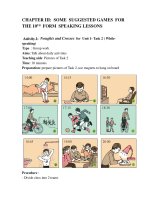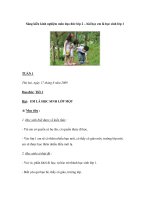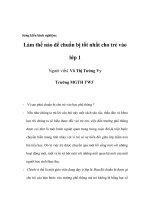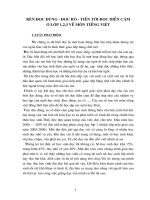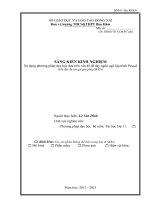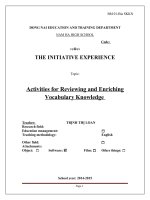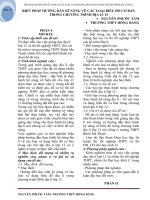SÁNG KIẾN KINH NGHIỆM Activities for Reviewing and Enriching Vocabulary Knowledge
Bạn đang xem bản rút gọn của tài liệu. Xem và tải ngay bản đầy đủ của tài liệu tại đây (252.23 KB, 21 trang )
DONG NAI EDUCATION AND TRAINING DEPARTMENT
NAM HA HIGH SCHOOL
Code:
THE INITIATIVE EXPERIENCE
Topic:
Activities for Reviewing and Enriching
Vocabulary Knowledge
Teacher: TRỊNH THỊ LOAN
Research field:
Education management:
Teaching methodology: English
Other field:
Attachments:
Object: Software: Film: Other things:
School year: 2014-2015
Page 1
BM 01-Bia SKKN
CURRICULUM VITAE
I.PERSONAL INFORMATION:
1. Full name: Trinh Thi Loan
2. Date of birth: July 2
nd
, 1985
3. Sex: Female
4. Address: 29A/6 Nguyen Ai Quoc Street, Tan Phong, Bien Hoa, Dong Nai
5. Telephone number: 01636991371
6. Email address:
7. Major: Teacher of English
8. Work Place: Nam ha high school
II. EDUCATIONAL BACKGROUND
-Diploma: Bachelor in 2007
-Major in: English teaching
III. SCIENTIFIC EXPERIENCE
-The length of service: 8 years
- The initiative experience:
1. Using English song to teach pronunciation (2012-2013)
-The two following works have conducted since joining the post graduate
diploma course.
2. Positive and negative learning experiences in working in groups in
speaking lessons among grade 10
th
students at Nam Ha high school (2014-
2015)
3. English textbook evaluation (2014-2015)
Page 2
BM02-LLKHSKKN
The table of content
Chapter 1: Introduction
1. Back ground of the study………………………. 4
2. The significant of the study…………………… 4
3. The study questions……………………………… 4
Chapter 2: Review of Relevant Literature
1. What is vocabulary? 5
2. Some guidelines for communicative treatment of vocabulary
instruction. ……………………………………… 5-6
3. Useful principles for vocabulary review and consolidation. 6
Chapter 3: Recommend the vocabulary activities
for grade eleventh students.
1. Word search puzzles…………………………………. 7-9
2. Word definition ……………………………………… 10
3. Word collocation…………………………………… 11
4. Word form…………………………………………… 12
5. Matching…………………………………………… 13
6. Crossword…………………………………………… 14-15
7. Scrambled letters…………………………………… 16
8. Spelling bee…………………………………………. 17
Chapter 4: Conclusion and suggestion …………… 18
Reference …………………………………………………… 19
Page 3
Chapter 1: Introduction
Vocabulary is considered an important tool to help students interpret their
ideas and express their feelings effectively. Students’ knowing lots of lexical
items ultimately lead to successes in language skills such as speaking,
listening, writing and listening. It is also vocabulary that partly facilitates the
movement of “passive” knowledge into “active” language use. Roughly
speaking, students are getting more competent and confident in using
language since they own the rich storehouse of vocabulary knowledge. In
reality, those roles of knowing vocabulary seem to be marginalized in
teaching and learning situations. More dangerously, the translation method
becomes dominant, which navigates to the situation of L1 overuse. The
textbook makes the problems worsen when presenting no room for purely
teaching and learning vocabulary. As a result, teachers tend to spend very
limited time on introducing the new lexical items and do not linger on
vocabulary practice. In some special cases, a few teachers are more
awareness of the possible potentials of vocabulary in the language family.
The evidence is that they deliberately check students’ memorization on the
words they have learnt. However, they do not vary the task types except for
dictation technique, which is considered to be at the expense of
communicative purposes. The same problems happen in my school, which
urges me to do something to address the mentioned dilemmas in the domain
of my school. I also hope that my work will be useful in many other
educational institutes.
The study is in attempt to answer the following questions:
1. What is vocabulary?
2. What are some useful techniques in introducing vocabulary?
3. When is the most suitable time for reviewing and consolidating
activities?
4. What are specific vocabulary activities for particular units for grade
eleventh students in the first semester?
The next chapter refers to some literature reviews that are relevant to my
mentioned concerns. By doing so, the study area becomes more clarity and
convincing.
Page 4
Chapter 2: Literature review
What is vocabulary?
According Ur. P (2012), vocabulary is referred as the lexical items of the
language including some aspects; such as, form (pronunciation and spelling)
meaning (denotation), grammar (certain grammar context), collocation,
connotation and appropriateness. So vocabulary is not just the words in the
language. It is much broader than what is familiarly attributed. In real
classroom, it is important for students to internalize all the possible domains
of vocabulary so that they can avoid wrongly using words and ruining their
harbored meanings.
Some guidelines for communicative treatment of vocabulary
instruction.
Obviously, students will remember the words longer once they are taught
effectively, so the stage of introducing vocabulary to students strengthen the
effects of the subsequent consolidation. Traditionally, teachers of English
tend to directly introduce the needed vocabulary to their students, by doing
so they can save time for the macro skills which are widely considered to be
more important than the language elements. As a result, students are to face
with lots of obstacles stemming from insufficient knowledge of vocabulary.
Spontaneously, their work on other skills no longer runs smoothly.
Unfortunately, such frequent interruption may damages students’ learning
motivation. In my opinion, practicing and reviewing vocabulary deserves to
be paid more attention and dedication from teachers and teachers should
lend the most effective teaching techniques as well as appropriate pedagogic
approaches to enhance students’ willingness to exposure to lexical items.
As suggested by Brown. H. D (2007), vocabulary items should not be
viewed as a long, boring list of words to be learned, they should be put in
their centre role in meaningful language. He also lists some practical
principles for using communicative teaching method to treat vocabulary
instruction as follow.
- Allocate specific class time to vocabulary learning. Words are believed the
first priority to make communication work, and the basic base of language
building blocks.
Page 5
-Help students to learn vocabulary in context. The words should appear in
the context of discourse or real communication rather than isolating words.
By doing so, students can articulate the new words in meaningful contexts
that they may encounter in real life.
- Play down the role of bilingual dictionary. This help student skip from
overusing bilingual dictionary, which makes students overtly depend on it
for word quick translation.
- Encourage students to develop strategies for determining the meanings of
words.
- Engage in “unplanned” vocabulary teaching. Teachers should be conscious
that the “unplanned” vocabulary teaching can be encouraged since it relates
to the ongoing activities.
These principles urge teachers to carefully design vocabulary activities to
benefits their learners and make the lessons more engaging to them.
Obviously, students can easily forget all about the words if they can see it no
other times. So to make sure their revisiting chance to the vocabulary they
have just learnt, students should be supplemented with some kinds of
reviewing and consolidating activities. This is regarded as the key point
deciding on the living span of words in someone’s minds. The sequence
presents some vital principles for more effective vocabulary review and
consolidation.
Useful principles for vocabulary review and consolidation
As mentioned by Ur. P (2012) “a learner needs to re-encounter a new item
several times in order to remember it permanently”. And he suggests that
every lesson should stick to provide students with several vocabulary review
work. His voice especially appeals the involvers when stating that the most
optimum principle is to make student memorize the words when they are not
totally dead in their minds. It may be done in the next lesson and some later
lessons as long as it naturally permanently lives in individuals. Another
essential principle focuses on the types of review tasks. In this sense, Ur
drives the attention to the purpose of review tasks by saying that “tasks that
review vocabulary aims to consolidate and deepen students’ basic
knowledge”. In this sense, students are supposed to engage successfully,
meaningfully and accurately with the target items, while teachers step back
to make more rooms for students’ self- orientation, self check, and correct
themselves.
Page 6
Chapter 3: Recommend the vocabulary
activities for grade eleventh students.
I introduce the number of vocabulary tasks for students to revisit the words
they have internalized from each unit in their text book. Each activity wastes
about five minutes, and it should happen at the beginning of the class.
Samples of activity
Sample 1: Unit 1: Friendship
Target vocabulary: Friendship
Activity: word search puzzles
Procedure:
-The teacher can create a paper-puzzle which is big enough to hang on the
board, or she can also design it on the PowerPoint.
- Students are assigned into different groups of about three or four students.
- The teacher instructs students the rules and the ways to do this puzzle.
- The winner is the one who is able to search the most correct words in the
shortest possible time.
- The teacher then shows the correct answer and gets individual group to
make as many sentences as possible using the words they have just found
out.
- For the last two minutes, students are encouraged to utilize dictionaries.
Instruction: Find and circle all of the words that are hidden in the grid
and the remaining letters spell an additional word related to friendship.
Page 7
ACQUAINTANCE
AFFECTION
AFFINITY
ALLY
AMIGO
AMITY
BOYFRIEND
BUDDY
CHUM
CLOSENESS
COMPANION
COMRADE
CONFIDE
EMPATHY
FAVOR
FONDNESS
FRIENDLINESS
FUN
GIRLFRIEND
GOOD TIMES
HONESTY
KINSHIP
LEND
LOYALTY
PAL
ROOMMATE
SHARE
SUPPORTIVE
SYMPATHY
TRUST
Page 8
The solution
Page 9
Sample 2: Unit 2: Personal experiences
Target vocabulary: embarrassing experiences
Activity: word definition
Procedure:
- T brings to class a list of uncompleted words of the topic of the unit.
- Students are put into pairs or groups to discover the entire word based on
the equivalent definition in the opposite column.
Instruction: Add two letters to any place of each word to form another
word with its definition given.
1. eat large in amount, size or degree
2. cool a place where children go to be educated
3. ink believe something or have an opinion or idea
4. stunt a person who is learning at a college or university,
or sometimes at school
5. art begin doing something
6. lit the brightness that comes from the sun, fire,
electrical devices, etc. that allows thing to be seen
7. change give something to someone and receive something
from them
8. all limited in size or amount when compared with
what is typical or average
9. sit go to a place in order to look at it, or to a person in
order to spend time with them
10. ring The season of the year between winter and summer
The answer:
1. Great 2. School 3. Think 4. Students 5. Start
6. Light 7. Exchange 8. Small 9. Visit 10. Spring
Sample 3 : Unit 3: A party
Target vocabulary: celebrations
Activity: word collocation
Procedure:
-The teacher has students form groups. Give each groups one worksheet.
- The teacher explains the activity: students work together to find the words.
Page 10
- Students should use pencils, if possible, as answers may need to be erased
and changed.
-The first group to have the list of complete words becomes the winner.
Options/Alternatives
-After checking the answers as a class, T asks students to write sentences
using the vocabulary from the list
- The teacher encourages some students to read their sentences to the class.
Instruction: Use a verb which can be collocated with the three words or
phrases.
1. g ………………… a card, a gift, flowers
2. h ………………… a party, a meeting, a conference
3. e………………… yourself, the food, a film
4. t ………………… a lie, a joke, the truth
5. g ………………… engage, married, divorced
6. c ………………… birthdays, the anniversary, the National day
7. a ………………… a party, class, school
8. h ………………… soft drinks, coffee, cake
9. w ………………… a hat, shoes, a t-shirt
10. s ………………… hello, goodbye, thank you
The answer:
1. Give 2. Hold 3. Enjoy 4. Tell 5. Get
6. Celebrate 7. Attend 8. Have 9. Wear 10. Say
Sample 4 : Unit 4: Volunteer work
Target vocabulary: voluntary
Activity: word form
Procedure:
-The teacher has students form pairs. Give each pairs one worksheet
- The teacher explains the activity, students work in pairs to find the right
word form for each gap.
Page 11
- Students should use pencils, if possible, as answers may need to be erased
and changed.
-The first pair to finish the task becomes the winner.
Options/Alternatives
- T may get students to write sentences using the vocabulary from the list.
Instruction: Fill in each gap in the sentence with the correct form of the
word in brackets.
1. She does __________ work for the Red Cross two days a week.
(volunteer)
2. When shall I do the ___________ (shop)
3. They want to improve public ____________, especially education.
(serve)
4. We finished the job, but only with great ____________. (difficult)
5. Some athletes take drugs to improve their ____________.
(performance)
6. Their grandchildren are a constant source of ___________. (happy)
7. At university, you have the ____________ to do what you want. (free)
8. There is a general ____________ that things will soon get better.
(believe)
9. A _______ is a person who climbs mountains as a sports or job.
(mountain)
10. One major_____________ of the area is the lack of public transport.
(advantages)
The answer:
1.Voluntary 2. Shopping 3, services 4. Difficulties/difficulty
5. Performances 6. Happiness 7. Freedom 8. Belief
9. Mountaineer 10. Advantage
Sample 5: Unit 5: Illiteracy
Target vocabulary: Illiteracy
Activity: Matching
Procedure:
- The handouts should be printed out and distributed to students.
- The teacher explains the activity, students work in pairs to do the matching
-After checking the answers with the whole class, the teacher asks students
to make sentences using pairs of antonyms.
Options/ alternatives
- The teacher calls on some pairs to read out their sentences.
Page 12
- The teacher makes copies the good sentences on the board.
Instruction: Matching a word in A with a word in B to make a pair of
antonyms.
A B
1. Male a. Unsuitable
2. literate b. majority
3. forget c. majority
4. increase d. insignificant
5. suitable e. irrelevant
6. remote f. remember
7. minority g. last
8. relevant h. near
9. substantial i. female
10. next j. decrease
The answer:
1. i 2. c 3. f 4.j 5. a
6. h 7. b 8. e 9. d 10. a
Sample 6: Unit 6: competition
Target vocabulary: event description
Activity: crossword puzzle
Procedure:
- The teacher designs a crossword on the topic of unit 6, it should be hung in
the board center. T may also deliver each to individual group as a small card.
-The teacher gets students to form groups of three or four to do the
crossword.
- The teacher reminds students not to look up dictionary or textbook.
- Students should use pencils in case they may need to change the answers.
-The first group to finish the task becomes the winner.
Options/Alternatives
-After checking the answers as a class, T has students write sentences using
the Vocabulary from the crossword.
- The teacher encourages some students to read their sentences to the class.
Page 13
Instruction: complete the crossword puzzle with the words needed for
the gaps in sentences below.
1. People with Asthma have ____________ in breathing.
2. I’m meeting a _____________ of friends for dinner tonight.
3. She gave a superb ______________ as Lady Macbeth.
4. We have to ____________ and pray that the operation will go well.
5. Children seem to have lost their _____________ in reading.
6. She’s won a lot of beauty _____________.
7. The defending____ will play his first match of the tournament
tomorrow.
8. You’ll have the ____________ to ask any questions to the end.
9. There was a lot of _____________ in preparation for the Queen’s visit.
10. A penalty in the last minute of the game leveled the ___________ 2-2.
11. Ladies and gentlemen, could I have your ___________, please?
12. She never lost her ___________ for teaching.
1 C
2 O
3 M
4 P
5 E
6 T
7 I
8 T
9 I
10 O
11 N
12 S
The answer:
1. Difficulty
2. Group
3. Performance
4. Hope
5. Enjoyment
Page 14
6. Contests
7. Champion
8. Opportunity
9. Activity
10. Score
11. Attention
12. Enthusiasm
Sample 7: Unit 7: World population
Target vocabulary: population
Activity: scrambled letters
Procedure:
-T prepares handouts of a jumbled letters in advance.
- T gets students to work in groups of three or four.
- T delivers the handouts and explains the rules: students have to reorder the
letters to make up the right words.
- The winner will be the group which builds all the correct words first.
Options/Alternatives
-After checking the answers as a class, T has students write sentences using
the vocabulary from the list.
- The teacher encourages students to read their sentences to the entire class.
Instruction: Arrange the letters to make 10 words you have learnt.
These words begin with the first letter.
1.eveosplix
2. moinlil
3. fugrei
4.rceroues
5.abeilaval
6.prentec
7.ghowtr
8.recaresh
9.briht
10.rkna
Page 15
The answer:
1. explosive 2. million
3. figure 4. resource
5. available 6. percent
7. growth 8. research
9. birth 10.rank
Sample 8: Unit 8: celebrations
Target vocabulary: population
Activity: Spelling bee
Procedure:
-Teacher dictates ten words that the students may have difficulty in spelling,
or that students have been recently taught. Ss write them down.
- T asks Ss to compare the answers in pairs and decide which spelling they
think is right.
- T gives the correct answer and then takes notes any words that students
have particular difficulties with for later review.
Options/Alternatives
- T may read L1 and students dictate equivalent L2, or directly say L2.
Introduction: Listen carefully and write the words down on a piece of
paper. You will hear each word twice.
1. agrarian 2. longevity
3. shrine 4. kumquat tree
5. preparation 6. adult
7. occasion 8. influence
9. exchange 10. comment
Page 16
Chapter 4: Conclusion and suggestion
Effect of application (school year: 2014-2015)
Class 11C3 (40) 11C9 (40)
The number of students claims their
interests in English before applying these
vocabulary activities
15 23
The number of students claims their
interests in English after applying these
vocabulary activities
33 39
The suggested activities are really practical to enhance students’ vocabulary
knowledge, develop their English skill abilities as well as boost their
motivation and interest in learning English .To some certain degrees, they
bridge the gap between the “up there” knowledge and language in use. In my
observation, my students are able to remember the words longer and flexibly
adapt them into their spoken speech and written form. In this sense, their
English ability is getting better and better in a short time. Teachers’
deliberated preparations for the activities remind students about the integral
part of lexical items, ultimately, they seriously intake those chunks of
language elements. However, reviewing and enriching should be done
regularly and systematically, otherwise, the results may be ruined. It is
advisable for the teacher to clearly state the instruction before letting
students do the tasks because they may get confused and maybe time passes
dully. Sometimes, teachers find that they cannot stay on this review stage
Page 17
because of time constraint. So it is suggested that the allowed time for
reviewing activities should be limited in about five or six minutes. I also
recommend that students should be distributed vocabulary tests, which
measures their vocabulary knowledge. At that time, lexical consolidation is
more focused by both teachers and students. Due to the limitation of my
teaching experience, every contribution to the vocabulary activities is highly
welcomed.
Reference:
Brown, H.D. (2007). Teaching by Principles: An Interactive Approach to
Language Pedagogy. (2
nd
ed.). New York: Longman.
Đặng Kim Anh và Đỗ Bích Hà, 2007. Rèn luyện từ vựng Tiếng anh 11. Nhà
xuất bản Giáo dục. Hà Nội.
Nguyễn Thùy Trang và Lương Quỳnh Trang, 2007. Thiết kế bài giảng Tiếng
anh 11. Nhà xuất bản Hà Nội. Hà Nội.
Ur, P. & Wright, A. (2008). Five Minute Activities. (8
th
ed.).Cambridge:
Cambridge University Press.
Ur, P. (2012). A Course in Language Teaching: Practice and Theory. (2
nd
ed.).Cambridge: CUP.
Website:
/>Page 18
Sở GD&ĐT Đồng Nai
Trường THPT Nam Hà
CỘNG HOÀ XÃ HỘI CHỦ NGHĨA VIỆT NAM
Độc lập - Tự do - Hạnh phúc
Biên hòa, ngày 09 tháng 05 năm 2015
PHIẾU NHẬN XÉT, ĐÁNH GIÁ SÁNG KIẾN KINH NGHIỆM
Năm học: 2014 - 2015
–––––––––––––––––
TÊN SÁNG KIẾN KINH NGHIỆM
Activities for Reviewing and Enriching Vocabulary Knowledge
- Họ và tên tác giả: Trịnh Thị Loan
- Chức vụ: Giáo viên
- Đơn vị: Trường THPT Nam Hà
Lĩnh vực: (Đánh dấu X vào các ô tương ứng, ghi rõ tên bộ môn hoặc lĩnh
vực khác)
- Quản lý giáo dục - Phương pháp dạy học bộ môn: Tiếng Anh
- Phương pháp giáo dục - Lĩnh vực khác: ……
Sáng kiến kinh nghiệm đã được triển khai áp dụng:
Tại đơn vị Trong Ngành
1. Tính mới (Đánh dấu X vào 1 trong 3 ô dưới đây)
Page 19
BM04-NXĐGSKKN
- Đề ra giải pháp thay thế hoàn toàn mới, bảo đảm tính khoa học, đúng đắn
- Đề ra giải pháp thay thế một phần giải pháp đã có, bảo đảm tính khoa học,
đúng đắn
- Giải pháp mới gần đây đã áp dụng ở đơn vị khác nhưng chưa từng áp dụng ở
đơn vị mình, nay tác giả tổ chức thực hiện và có hiệu quả cho đơn vị
2. Hiệu quả (Đánh dấu X vào 1 trong 5 ô dưới đây)
- Giải pháp thay thế hoàn toàn mới, đã được thực hiện trong toàn ngành có
hiệu quả cao
- Giải pháp thay thế một phần giải pháp đã có, đã được thực hiện trong toàn
ngành có hiệu quả cao
- Giải pháp thay thế hoàn toàn mới, đã được thực hiện tại đơn vị có hiệu quả
cao
- Giải pháp thay thế một phần giải pháp đã có, đã được thực hiện tại đơn vị có
hiệu quả
- Giải pháp mới gần đây đã áp dụng ở đơn vị khác nhưng chưa từng áp dụng ở
đơn vị mình, nay tác giả tổ chức thực hiện và có hiệu quả cho đơn vị
3. Khả năng áp dụng (Đánh dấu X vào 1 trong 3 ô mỗi dòng dưới đây)
- Cung cấp được các luận cứ khoa học cho việc hoạch định đường lối,
chính sách:
Trong Tổ/Phòng/Ban Trong cơ quan, đơn vị, cơ sở GD&ĐT
Trong ngành
- Đưa ra các giải pháp khuyến nghị có khả năng ứng dụng thực tiễn, dễ thực
hiện và dễ đi vào cuộc sống:
Trong Tổ/Phòng/Ban Trong cơ quan, đơn vị, cơ sở GD&ĐT
Trong ngành
- Đã được áp dụng trong thực tế đạt hiệu quả hoặc có khả năng áp dụng đạt hiệu
quả trong phạm vi rộng:
Trong Tổ/Phòng/Ban Trong cơ quan, đơn vị, cơ sở GD&ĐT
Trong ngành
Xếp loại chung: Xuất sắc Khá Đạt Không xếp loại
Cá nhân viết sáng kiến kinh nghiệm cam kết và chịu trách nhiệm không
sao chép tài liệu của người khác hoặc sao chép lại nội dung sáng kiến kinh
nghiệm cũ của mình.
Tổ trưởng và Thủ trưởng đơn vị xác nhận đã kiểm tra và ghi nhận sáng
kiến kinh nghiệm này đã được tổ chức thực hiện tại đơn vị, được Hội đồng
chuyên môn trường xem xét, đánh giá; tác giả không sao chép tài liệu của
người khác hoặc sao chép lại nội dung sáng kiến kinh nghiệm cũ của chính
tác giả.
Page 20
Phiếu này được đánh dấu X đầy đủ các ô tương ứng, có ký tên xác nhận
của tác giả và người có thẩm quyền, đóng dấu của đơn vị và đóng kèm vào
cuối mỗi bản sáng kiến kinh nghiệm.
NGƯỜI THỰC HIỆN
SKKN
(Ký tên và ghi rõ họ tên)
XÁC NHẬN CỦA TỔ
CHUYÊN MÔN
(Ký tên và ghi rõ họ tên)
THỦ TRƯỞNG ĐƠN VỊ
(Ký tên, ghi rõ
họ tên và đóng dấu)
Page 21
